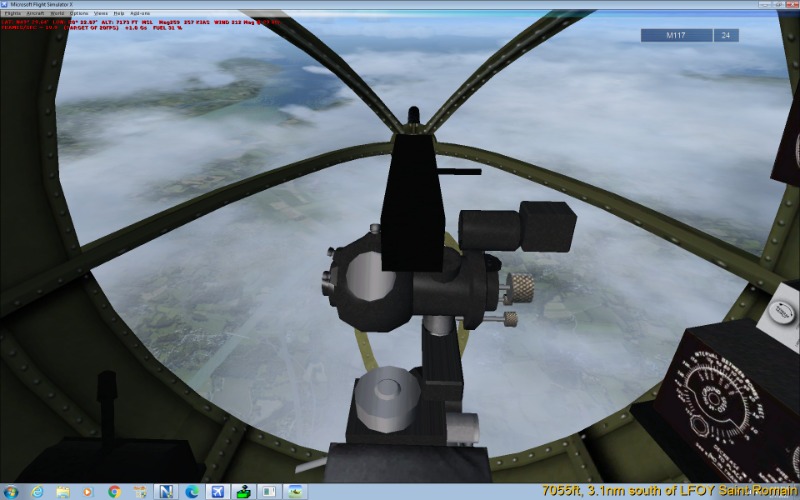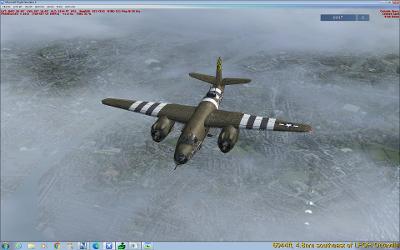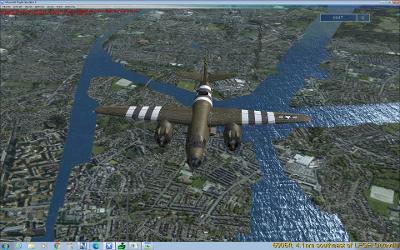- Forum
- 387th Bomb Group Project
- Official Flight Reports
- 387th Bomb Group Initial Operations from Station 162
387th Bomb Group Initial Operations from Station 162
4 years 10 months ago - 4 years 10 months ago #16853
by Westcoast
387th Bomb Group Initial Operations from Station 162 was created by Westcoast
I've now "previewed" two of the initial operational missions to be included in Phase 4 of the 387th Bomb Group Project. Two strikes were made against the Luftwaffe Base at St. Omer (M3: Aug. 15, 1943). St. Omer is "behind" Calais (nautical terminology), less than a half hour flying time from base. Some Luftwaffe bases are just 20 minutes away ! The first mission was uneventful in reasonably good weather and resulted in moderate to poor results with most bombs striknig several thousand feet north of the main runway (09/27). This was attributable to the bombardier being unable to identify the aiming point early enough in the bomb run to effect a stable bombsite solution. The second was conducted in poor weather using dead reckoning unaided by visual waypoint identification, and, although the target was eventually identified, that happened too late in the mission for asuccessful bomb run and, no alternte target having been assigned, I returned to base. Unfortunately, the ceiling at Station 162 had lowered to 300 ft.. A landing was attempted at nearby RAF Stansted, but was unsuccessful.
Yesterday, I flew a mission against the Rouen Coal Fired power plant (M8: Aug. 25, 1943). There is no longer a coal fired power plant in Rouen, but there is one in the harbor at nearby Le Harvre, at the mouth of the Seine. Again, there was a low ceiling in Essex and heavy overcast over the channel. However, there was sufficient clearing that both the waypoint crossing the French coast and the IP for the bomb run were visually identified and a good bomb run was initiated, both indicating very good dead reckoning navigation. However, as we approached Le Havre, the cloud coverage increased to scattered and the bombardier was unable to locate the target aimpoint.
The bombs were dropped on a built-up area on the planned bomb run line, but significantly short of the power plant.
You can see the bombs impacting, and, in a higher resolution screen shot, you can see several more still falling.
The second photo shows the scene with the weather removed, this will be our technique for scoring a bomb run.
Given that France is occupied territory and not enemy territory, this is contrary to operational guidance, and the bombs should not have been salvoed without positive identification of the aim point. On reurn to base, the ceiling was found to be 700' OVC, so it was necessary to use the NDB at Stansted to approach the field and to descend to about 1000' to make a somewhat ragged approach to Rwy 23 at EGSS. The landing was hard but successful.These preliminary strikes reveal several problems which will have to be addressed to achieve successful operations. The first is that the weather is poor in NW Europe, even in mid-summer, so we are going to have to become much better at decoding weather forecasts. The second is that it is difficult to identify checkpoints through the weather and the navigator needs a more detailed briefing to enable him to identify visual scenery clues leading to the target. On top of that, it is often necessary to descend from the planned altitude (e.g., 10,000') to break out of the weather. This exposes our aircraft to increased flak accuracy and means that the current bomb ballisitcs tables for altitudes of 2000' and 10000' will have to be augmented for intermediate alttudes, so that the bombardier can recalculate his aim point for a bomb run at, say 6000'. Lots of work to do.
Yesterday, I flew a mission against the Rouen Coal Fired power plant (M8: Aug. 25, 1943). There is no longer a coal fired power plant in Rouen, but there is one in the harbor at nearby Le Harvre, at the mouth of the Seine. Again, there was a low ceiling in Essex and heavy overcast over the channel. However, there was sufficient clearing that both the waypoint crossing the French coast and the IP for the bomb run were visually identified and a good bomb run was initiated, both indicating very good dead reckoning navigation. However, as we approached Le Havre, the cloud coverage increased to scattered and the bombardier was unable to locate the target aimpoint.
The bombs were dropped on a built-up area on the planned bomb run line, but significantly short of the power plant.
You can see the bombs impacting, and, in a higher resolution screen shot, you can see several more still falling.
The second photo shows the scene with the weather removed, this will be our technique for scoring a bomb run.
Given that France is occupied territory and not enemy territory, this is contrary to operational guidance, and the bombs should not have been salvoed without positive identification of the aim point. On reurn to base, the ceiling was found to be 700' OVC, so it was necessary to use the NDB at Stansted to approach the field and to descend to about 1000' to make a somewhat ragged approach to Rwy 23 at EGSS. The landing was hard but successful.These preliminary strikes reveal several problems which will have to be addressed to achieve successful operations. The first is that the weather is poor in NW Europe, even in mid-summer, so we are going to have to become much better at decoding weather forecasts. The second is that it is difficult to identify checkpoints through the weather and the navigator needs a more detailed briefing to enable him to identify visual scenery clues leading to the target. On top of that, it is often necessary to descend from the planned altitude (e.g., 10,000') to break out of the weather. This exposes our aircraft to increased flak accuracy and means that the current bomb ballisitcs tables for altitudes of 2000' and 10000' will have to be augmented for intermediate alttudes, so that the bombardier can recalculate his aim point for a bomb run at, say 6000'. Lots of work to do.
Attachments:
Last edit: 4 years 10 months ago by Westcoast.
Please Log in to join the conversation.
- Forum
- 387th Bomb Group Project
- Official Flight Reports
- 387th Bomb Group Initial Operations from Station 162
Time to create page: 0.219 seconds



